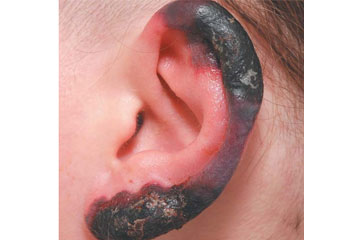Strange Condition Causes 'Frostbite' At 50 Degrees

A woman in Germany developed what looked like frostbite on her nose, ears and legs, even though she had not been exposed to extremely cold temperatures, according to a new report of her case.
Her skin developed black regions, made up of damaged skin tissue, which appeared over several days.
The heating system in her house had failed for a few days, and outside temperatures dropped to 50 degrees Fahrenheit (10 degrees Celsius), the report said.
Doctors diagnosed the woman with a type of autoimmune diseasethat is triggered by cold temperatures. [See 9 Oddest Medical Cases.]
The woman had high levels of antibodies called "cold agglutinins" in her body. Most people have low levels of cold agglutinins, which help the body respond to infection.
When levels of cold agglutinins are too high, they cause red blood cells to clump together, and the clumps can block the flow of blood to the fingers, nose, ears and toes, consequently causing symptoms similar to frostbite.
Doctors removed the damaged skin and treated the woman with drugs that prevent blood clots. She also underwent plasmapheresis, a procedure to purify the blood, and was told to protect herself from cold. The patient's symptoms improved, the doctors said.
Sign up for the Live Science daily newsletter now
Get the world’s most fascinating discoveries delivered straight to your inbox.
The report of her case is published in the July 4 issue of the New England Journal of Medicine.
Follow Rachael Rettner @RachaelRettner. Follow LiveScience @livescience, Facebook & Google+. Original article on LiveScience.com

Rachael is a Live Science contributor, and was a former channel editor and senior writer for Live Science between 2010 and 2022. She has a master's degree in journalism from New York University's Science, Health and Environmental Reporting Program. She also holds a B.S. in molecular biology and an M.S. in biology from the University of California, San Diego. Her work has appeared in Scienceline, The Washington Post and Scientific American.










